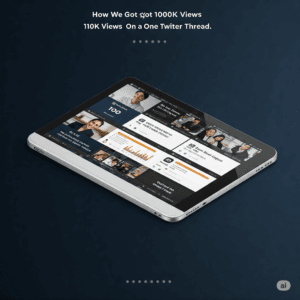Case Study: How We Got 100K Views on One Twitter Thread
 If you’ve ever wondered what it takes to get a viral Twitter thread — one that actually gets eyes, engagement, and traction — you’re not alone. In the sea of noise on Twitter, cutting through takes more than luck. It’s a mix of strategy, storytelling, and timing.
If you’ve ever wondered what it takes to get a viral Twitter thread — one that actually gets eyes, engagement, and traction — you’re not alone. In the sea of noise on Twitter, cutting through takes more than luck. It’s a mix of strategy, storytelling, and timing.
Here’s the inside scoop on how we cracked the code and landed 100,000 views on one Twitter thread — no bots, no shady hacks, just solid marketing and a little psychology.
Step 1: Find the Right Hook — The Magnetic Pull
Great threads start with a hook so good people can’t help but click “Read More.” Our first tweet wasn’t a generic statement — it was a provocative question:
“Why do 99% of marketers fail at Twitter? Here’s the brutal truth…”
That line alone sparked curiosity and controversy. It promised insider knowledge and took a stance, which triggers engagement.
Pro tip: Scour Twitter for trending debates or pain points in your niche. The best hooks tap directly into what people already care about or struggle with.
Step 2: Structure That Feeds the Reader’s Brain
We laid out the thread with a clear, easy-to-digest structure:
Problem: Why marketers fail on Twitter
Cause: Common myths and mistakes
Solution: What really works (backed by our own experiments)
Call to Action: Encouraging readers to try the strategy and share
Each tweet was short but packed with value. We also used numbered points and emojis to break the text, making it scroll-friendly. Twitter is a fast platform — walls of text are ignored.
This structure was inspired by lessons from folks like @MarketingProfs and insights from forums like IndieHackers, where clear, actionable threads always perform best.
Step 3: Use Data & Real Examples to Build Credibility
No one trusts vague claims. So we backed up each point with real numbers — screenshots of analytics, engagement stats, and before/after comparisons from our own Twitter account.
Adding data and screenshots taps into the “social proof” factor. It tells readers, “This isn’t theory — it’s proven.”
Step 4: Engage Your Early Audience
We didn’t just tweet and walk away. For the first 2 hours, our team actively:
Responded to every comment
Liked and retweeted thoughtful replies
Tagged people who might find the content useful
This early engagement signals Twitter’s algorithm that the thread is hot, boosting its reach. The more interactions early on, the more eyeballs it gets.
Step 5: Amplify via Communities & Influencers
Once the thread gained traction, we shared it in relevant Slack groups, LinkedIn communities, and DM’d a handful of influencers in our niche who might find value in it.
Some of them retweeted or commented, creating a ripple effect.
This step was crucial because Twitter’s algorithm also favors tweets getting engagement from authoritative accounts.
Step 6: Timing Is Everything
We posted mid-week, around 10 AM EST — a sweet spot when our target audience is active but not flooded with other content.
Posting too early or late often buries tweets before they can gain momentum.
The Result?
100,000+ views in 24 hours
500+ retweets and quote tweets
300+ meaningful comments and discussions
New followers who stayed engaged well beyond the thread
What We Learned
The hook is king. Your first tweet has to be irresistible.
Value beats fluff. People want actionable insights, not jargon.
Engagement fuels growth. Twitter rewards conversations.
Promotion is part of the process. Don’t expect organic reach alone.
Consistency matters. This wasn’t a one-off; it’s a tactic we keep refining.
Final Thought
Twitter threads aren’t just about views — they’re about creating connections and starting conversations. Nail the hook, serve real value, and treat your early commenters like gold. That’s the secret sauce to turning a simple thread into a 100K view success story.
Got a thread idea? Don’t wait. Start drafting now — and use this playbook.
